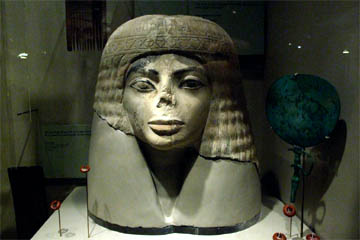The Pharaoh of Pop
Curators at the Chicago Field Museum were puzzled recently at an unexpected surge of interest in one particular statue in their Egyptian section. Of course they were used to school children oohing and aahing over the twenty-three mummies, men showing a detached interest in the depictions of Egyptian women in near-transparent linen dresses or women manifesting a professional interest in Egyptian cosmetics, but this was something different. The object of the fuss was the head of an unknown woman, probably part of a stone sarcophagus, and it wasn't even in good condition - the nose was half-missing, everything below the chin had been broken off, even the wig was a perfectly standard wig. Hitherto the head had had somewhat of the status of "the stone which the builders rejected", now it had suddenly become "the head of the corner".

|
| The head of an unknown Egyptian woman, part of a sarcophagus, now in the Chicago Field Museum. |
Curators, as I say, were puzzled. Flocks of girls dabbing handkerchiefs and tissues at tear-stained eyes, young men in dreadlocks looking reverential and solemn, even adults queueing up to take photographs, such interest in an exhibit had never been seen before. And then someone spotted one of the youths walking backwards while aparently going forwards and took another look at the Egyptian woman.
Broken nose, pouty lips, large eyes - Michael Jackson!
Soon articles in newspapers and on the internet appeared, speculating on a connection between the statue and the pop artist. Some, under the mistaken impression that the statue was that of an ancient Egyptian pharaoh, drew entirely spurious parallels between the "king of pop" and the "king of Egypt", others dubbed Jackson the "pharaoh of pop", while still others speculated that Jackson may have demanded to be remodelled by his plastic surgeons to look like the statue. As it is unlikely that Jackson, despite his kinky proclivities, really wanted to look like a woman, we can't take such ideas seriously.
Whether the unknown woman would have been pleased at being mistaken for a pop singer of uncertain talent and dubious fascination with young children we will never know. The authorities of the Chicago Field Museum had no such qualms: anything that brought the public flocking in could only be a Good Thing. The head was moved to a more prominent position in the permanent exhibition "Inside Ancient Egypt" and the caption for the photograph on the museum website ammended to read, "Remains of a Coffin (ie Michael Jackson's ancestor)" - which, of course, it most certainly is not.
Chicago Field Museum The name comes from the museum's first major benefactor, Marshall Field, rather than from its location or its purpose. Marshall Field was a successful businessman and reportedly the originator of the slogan, "the customer is always right", an attitude on which his company was founded and by which it prospered. Nonetheless, he does not appear to have been a terribly nice man and was only persuaded to give a million dollars to the new museum because it would make him famous. A further eight million after his death doubtless had the same motive. Return
© Kendall K. Down 2009





